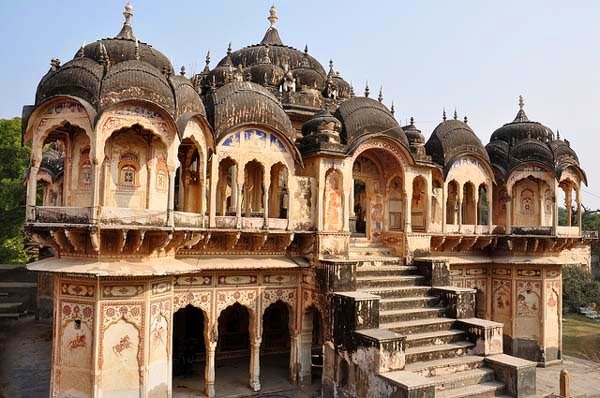Places to Visit in Shekhawati (Mandawa)
Shekhawati is a semi-arid historical region located in
the northeast part of Rajasthan, India. Shekhawati is located in North
Rajasthan comprising districts like Jhunjhunu, Sikar, Churu and a part of
Nagaur and Jaipur. History has it that in the 17th to 19th centuries, Marwari
merchants constructed these grand havelis in the Shekhawati region. Steeped in
wealth and affluence, these merchants got busy outdoing others in building more
grand edifices – homes, temples, step wells which were richly decorated both
inside and outside with painted murals. It is bounded on the northwest by the
Jangladesh region, on the northeast by Haryana, on the east by Mewat, on the
southeast by Dhundhar, on the south by Ajmer, and on the southwest by the
Marwar region. Its area is 13784 square kilometers. The inhabitants of
Shekhawati are considered brave, sacrificing and hard working people.

Sethani Ka Johara lies on the north side of the road
perhaps 5 km west of Churu along the Ratangarh road. It is perhaps the finest
johara (reservoir) in the area in that it is not only attractive but also
efficient, holding a store of water, often from one monsoon to the next. It was
built in 1899 by the widow of Bhagwan Das Bagla as part of the famine relief
projects that the merchants financed in those terrible years of the close of
the century. A peaceful place, it attracts various birds and animals, including
Nilgais, in winter.
Kanhaiyalal Bagla Haveli is a beautiful structure, which
stands on the south of the main bazaar. Constructed in around 1880, the haveli
represents the finest lattice work and architectural styles in the entire
Shekhawati region. The murals and wall paintings of the haveli depict Dhola and
Maru, the romantic couple from folk tales, on a camel. The walls of the haveli
are also adorned with the episodes of Dhola- Maru, the lovers fleeing on their
camel.

Aath Kambh Chhatri, one of the buildings possessing great
historical significance, is an eight pillared dome that stands on the northern
side of the town. Lying between the premises adjoining the western side of the
vegetable market, the chhatri is believed to be constructed in 1776. Over the
years, the windblown sand has virtually buried the base of the structure, while
the interiors are still adorned with beautiful murals and stone carved
paintings.
Located on the Agra-Bikaner Highway, the Ratangarh Fort
was built in the early 18th century by Surat Singh, who named it after his son
Ratan Singh, and boasts imposing gateways, several monuments (which are mostly
in ruins today) and a clock tower, which is also known as Ghantaghar. The
Ratangarh Fort makes for a lovely tourist destination, surrounded by several
ethnic villages.
Soothing to the eye, this temple is simple from the
outside but has a grand architectural splendour from within. The entrance has a
projected foliated arch adorned with beautiful mural paintings. It is easily
accessible from all parts of Churu, and the serenity of this temple makes it a
must-visit in your itinerary.
The Jain Temple is a 150-year-old structure and can be
described as piece of art in itself. Its interiors resemble a lavish royal
court than a temple courtyard. This temple has some of the best paintings
painted in gold, centred mostly on moral living suggestions. The walls and the
interior are adorned with glass works characteristic of the magnificence of the
Rajput era.
Renowned for being a safe haven black bucks and a variety
of birds, this sanctuary is named after the Chhapar village. Located in the
Sujangarh Tehsil of Churu, it is 210 km from Jaipur. Its open grasslands
scattered with trees give it the appearance of a savannah. The sanctuary is a
bird watcher’s paradise as it is home to birds such as eastern imperial eagle,
black ibis, demoiselle cranes, skylarks, ring doves and more. One can also spot
the desert fox and desert cat here.
Raghunathji Mandir, also known as Bara Mandir, is located
in the vicinity of the Ratangarh town. Dedicated to Lord Raghunath or Rama, an
incarnation of Lord Vishnu, the temple is believed to be constructed in early
19th century. It is a single storied temple with an elevated entrance. The top
of the temple has a series of cupolas. The temple is believed to liberate one
from the pains of life.
Rani Sati Mandir is a well-known temple situated in
Jhunjhunu district in the Rajasthan. This temple has a history of more than 400
years and is an indication to feminine bravery and spirit. It is also famous
for its magnificence, and extraordinary paintings. It is also part of one of
the oldest presented Indian pilgrimages.

It is a modern, single-storeyed temple with a surrounding
shikhara and pinnacle. It is one of the most popular Hanuman temples in India.
The idol of Balaji here is different from all other idols of Hanuman. Unlike
other projections and idols of Hanuman, Balaji possess round face with
moustache and beard making it the most unique idol among the other idols of
Hanuman all over the world.
Located midway between Jhunjhunu and Sikar, Nawalgarh is
well-known for its stunning havelis. It is also a favoured spot for film makers
and many Indian and International movies have been shot here. A famous
attraction here is the Nawalgarh Fort, which was built by Thakur Nawal Singh.
The Roop Niwas Palace, located one km from Nawalgarh fort is a charming palace
with beautiful gardens and fountains. It is now a heritage hotel.



Comments
Post a Comment